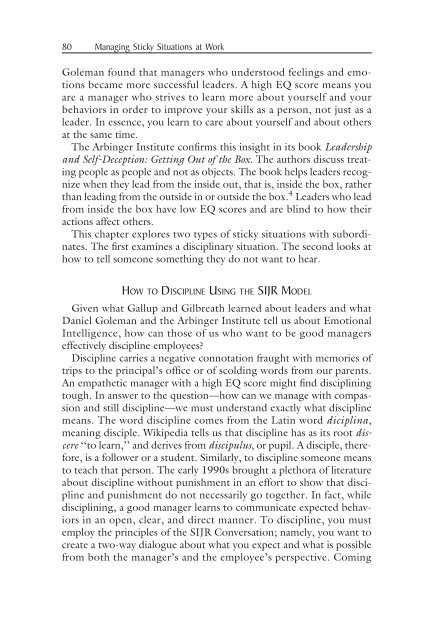Managing Sticky Situations at Work
Managing Sticky Situations at Work
Managing Sticky Situations at Work
You also want an ePaper? Increase the reach of your titles
YUMPU automatically turns print PDFs into web optimized ePapers that Google loves.
80 <strong>Managing</strong> <strong>Sticky</strong> <strong>Situ<strong>at</strong>ions</strong> <strong>at</strong> <strong>Work</strong>Goleman found th<strong>at</strong> managers who understood feelings and emotionsbecame more successful leaders. A high EQ score means youare a manager who strives to learn more about yourself and yourbehaviors in order to improve your skills as a person, not just as aleader. In essence, you learn to care about yourself and about others<strong>at</strong> the same time.The Arbinger Institute confirms this insight in its book Leadershipand Self-Deception: Getting Out of the Box. The authors discuss tre<strong>at</strong>ingpeople as people and not as objects. The book helps leaders recognizewhen they lead from the inside out, th<strong>at</strong> is, inside the box, r<strong>at</strong>herthan leading from the outside in or outside the box. 4 Leaders who leadfrom inside the box have low EQ scores and are blind to how theiractions affect others.This chapter explores two types of sticky situ<strong>at</strong>ions with subordin<strong>at</strong>es.The first examines a disciplinary situ<strong>at</strong>ion. The second looks <strong>at</strong>how to tell someone something they do not want to hear.HOW TO DISCIPLINE USING THE SIJR MODELGiven wh<strong>at</strong> Gallup and Gilbre<strong>at</strong>h learned about leaders and wh<strong>at</strong>Daniel Goleman and the Arbinger Institute tell us about EmotionalIntelligence, how can those of us who want to be good managerseffectively discipline employees?Discipline carries a neg<strong>at</strong>ive connot<strong>at</strong>ion fraught with memories oftrips to the principal’s office or of scolding words from our parents.An emp<strong>at</strong>hetic manager with a high EQ score might find discipliningtough. In answer to the question—how can we manage with compassionand still discipline—we must understand exactly wh<strong>at</strong> disciplinemeans.TheworddisciplinecomesfromtheL<strong>at</strong>inworddiciplina,meaning disciple. Wikipedia tells us th<strong>at</strong> discipline has as its root discere‘‘to learn,’’ and derives from discipulus, or pupil. A disciple, therefore,is a follower or a student. Similarly, to discipline someone meansto teach th<strong>at</strong> person. The early 1990s brought a plethora of liter<strong>at</strong>ureabout discipline without punishment in an effort to show th<strong>at</strong> disciplineand punishment do not necessarily go together. In fact, whiledisciplining, a good manager learns to communic<strong>at</strong>e expected behaviorsin an open, clear, and direct manner. To discipline, you mustemploy the principles of the SIJR Convers<strong>at</strong>ion; namely, you want tocre<strong>at</strong>e a two-way dialogue about wh<strong>at</strong> you expect and wh<strong>at</strong> is possiblefrom both the manager’s and the employee’s perspective. Coming















